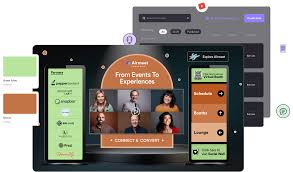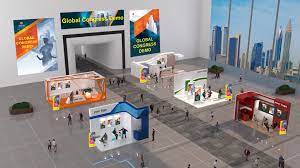The Rise of Hybrid Virtual Event Platforms
In today’s rapidly evolving digital landscape, the concept of hybrid virtual event platforms has gained significant traction. Combining the best of both physical and virtual events, these platforms offer a unique and engaging experience for participants.
Hybrid virtual event platforms allow attendees to participate in events both in-person and online. This flexibility enables organizations to reach a wider audience while providing a seamless experience for all participants. With features such as live streaming, virtual networking, and interactive sessions, these platforms offer a dynamic and immersive event experience.
One of the key advantages of hybrid virtual event platforms is their ability to adapt to changing circumstances. In the face of travel restrictions and social distancing measures, organizations can seamlessly transition their events from physical to virtual or hybrid formats without compromising on engagement or quality.
Furthermore, hybrid virtual event platforms offer valuable data insights that can help organizers measure the success of their events and make informed decisions for future iterations. By tracking attendee engagement, feedback, and participation rates, organizations can optimize their events for maximum impact.
As we continue to navigate the challenges posed by the global pandemic and embrace the opportunities presented by digital technologies, hybrid virtual event platforms are poised to play a pivotal role in shaping the future of events. By combining the best elements of physical and virtual experiences, these platforms offer a versatile solution that meets the needs of today’s dynamic landscape.
Mastering Hybrid Virtual Events: Your Guide to Platforms, Differences, and Hosting Essentials
- What is an example of a virtual event platform?
- What should I look for in a hybrid event platform?
- What is the difference between a hybrid and virtual event?
- What is the best platform for virtual event?
- How do you host a hybrid virtual event?
- What is a virtual hybrid?
- What is a hybrid event platform?
What is an example of a virtual event platform?
When considering examples of virtual event platforms, one prominent option that often comes to mind is Hopin. Hopin is a versatile platform that offers a wide range of features for hosting virtual events, including live streaming, interactive sessions, networking opportunities, and exhibitor booths. With its user-friendly interface and robust capabilities, Hopin has become a popular choice for organizations looking to create engaging and immersive virtual event experiences.
What should I look for in a hybrid event platform?
When considering a hybrid event platform, there are several key factors to keep in mind to ensure a successful event. First and foremost, look for a platform that offers seamless integration between in-person and virtual components, enabling a cohesive experience for all participants. Additionally, prioritize features such as robust live streaming capabilities, interactive engagement tools, and comprehensive analytics to track attendee participation and measure event success. Customization options, reliable technical support, and scalability are also important considerations when selecting a hybrid event platform that meets your specific needs and goals.
What is the difference between a hybrid and virtual event?
When comparing a hybrid event to a virtual event, the key distinction lies in the format and attendee experience. A virtual event is entirely online, with participants engaging remotely through digital platforms, while a hybrid event combines both in-person and virtual elements. In a hybrid event, attendees have the option to participate either physically or virtually, offering greater flexibility and reach. This dual approach allows for a more dynamic and inclusive event experience, catering to diverse preferences and circumstances. Ultimately, the difference between a hybrid and virtual event lies in the blend of physical and digital components, providing organizers with versatile options to engage their audience effectively.
What is the best platform for virtual event?
When considering the best platform for a virtual event, it is essential to evaluate various factors such as the specific needs of the event, budget constraints, desired features, and technical requirements. There is no one-size-fits-all answer to this question as different platforms offer unique strengths and capabilities. It is recommended to research and compare multiple platforms to identify the one that aligns most closely with the goals and objectives of the event. Conducting thorough testing and seeking recommendations from industry experts can also help in making an informed decision on selecting the best platform for a successful virtual event.
How do you host a hybrid virtual event?
Hosting a hybrid virtual event involves a strategic blend of in-person and online elements to create a seamless and engaging experience for attendees. To host a successful hybrid virtual event, organizers need to carefully plan and coordinate both the physical and digital aspects of the event. This includes choosing the right technology platform for live streaming, interactive sessions, and virtual networking, as well as ensuring that all attendees have access to the necessary tools and information to participate effectively. By combining the best practices of traditional event planning with innovative digital solutions, organizers can create a dynamic and inclusive event that caters to both in-person and remote participants.
What is a virtual hybrid?
A virtual hybrid event combines elements of both physical and virtual events, offering participants the flexibility to attend either in person or online. This innovative approach allows organizers to reach a broader audience while providing a seamless and interactive experience for all attendees. By leveraging technology such as live streaming, virtual networking, and interactive sessions, virtual hybrid events create a dynamic environment that bridges the gap between traditional and digital event formats.
What is a hybrid event platform?
A hybrid event platform is a comprehensive digital solution that seamlessly integrates both in-person and virtual components to create a dynamic and engaging event experience. This innovative platform allows organizers to host events that cater to both physical attendees and remote participants, offering a flexible and inclusive environment for all. By leveraging features such as live streaming, interactive sessions, virtual networking opportunities, and data analytics, hybrid event platforms enable organizations to expand their reach, enhance audience engagement, and adapt to changing circumstances with ease.




